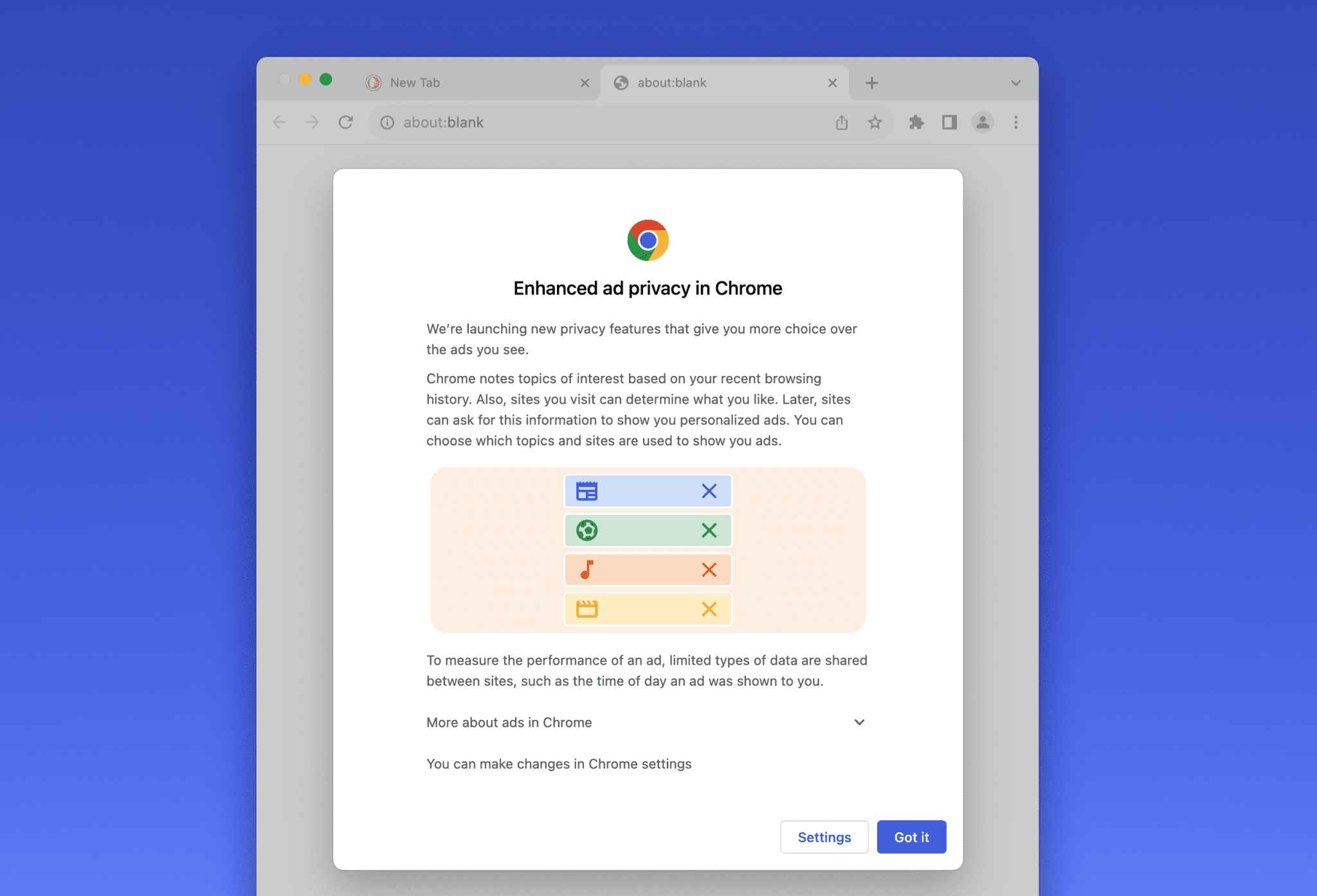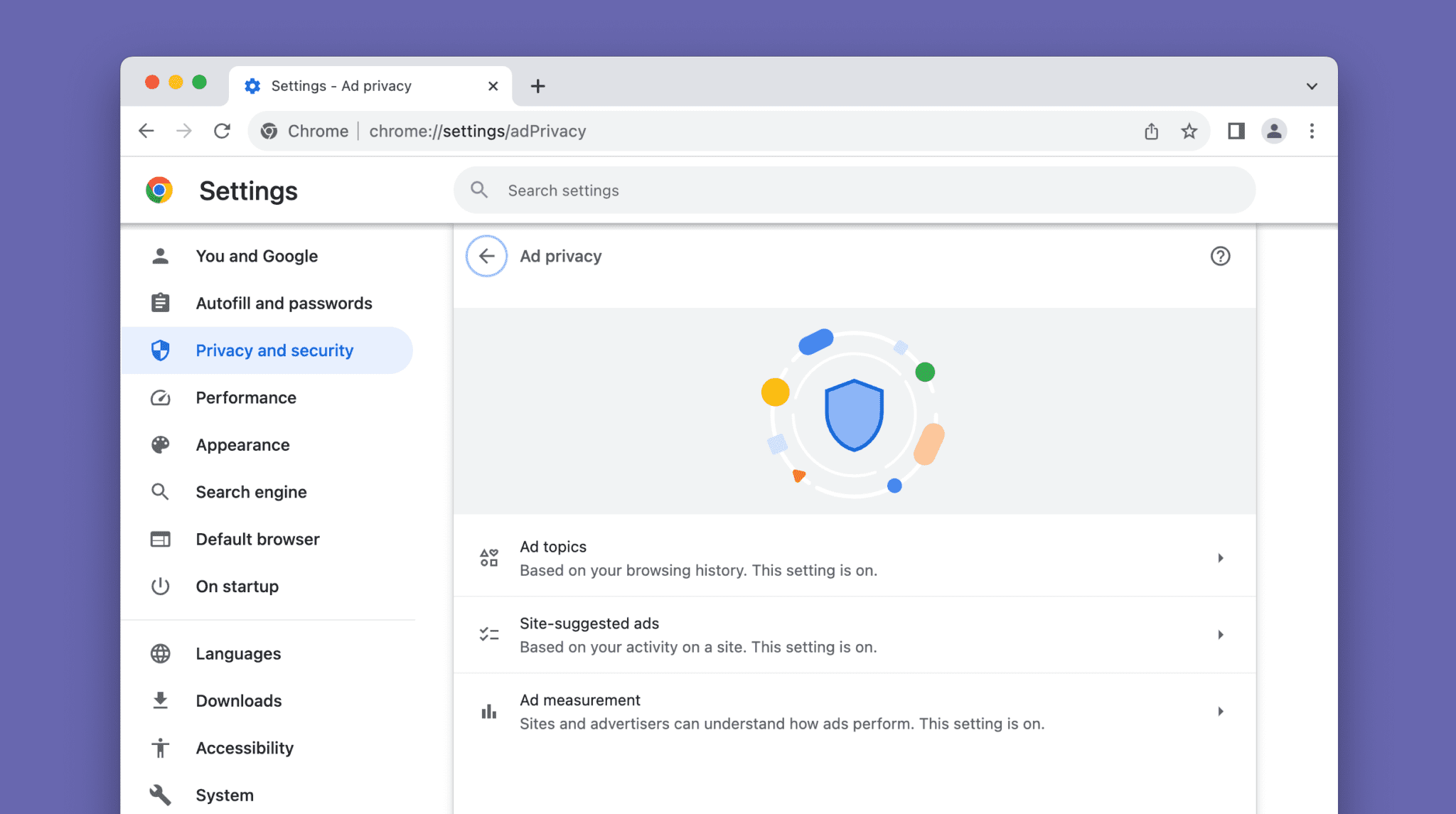Google has rolled out “Privacy Sandbox,” a Chrome feature first announced back in 2019 that, among other things, exchanges third-party cookies—the most common form of tracking technology—for what the company is now calling “Topics.” Topics is a response to pushback against Google’s proposed Federated Learning of Cohorts (FLoC), which we called “a terrible idea” because it gave Google even more control over advertising in its browser while not truly protecting user privacy. While there have been some changes to how this works since 2019, Topics is still tracking your internet use for Google’s behavioral advertising.
If you use Chrome, you can disable this feature through a series of three confusing settings.
With the version of the Chrome browser released in September 2023, Google tracks your web browsing history and generates a list of advertising “topics” based on the web sites you visit. This works as you might expect. At launch there are almost 500 advertising categories—like “Student Loans & College Financing,” “Parenting,” or “Undergarments”—that you get dumped into based on whatever you’re reading about online. A site that supports Privacy Sandbox will ask Chrome what sorts of things you’re supposedly into, and then display an ad accordingly.
The idea is that instead of the dozens of third-party cookies placed on websites by different advertisers and tracking companies, Google itself will track your interests in the browser itself, controlling even more of the advertising ecosystem than it already does. Google calls this “enhanced ad privacy,” perhaps leaning into the idea that starting in 2024 they plan to “phase out” the third-party cookies that many advertisers currently use to track people. But the company will still gobble up your browsing habits to serve you ads, preserving its bottom line in a world where competition on privacy is pushing it to phase out third-party cookies.
Google plans to test Privacy Sandbox throughout 2024. Which means that for the next year or so, third-party cookies will continue to collect and share your data in Chrome.
The new Topics improves somewhat over the 2019 FLoC. It does not use the FLoC ID, a number that many worried would be used to fingerprint you. The ad-targeting topics are all public on GitHub, hopefully avoiding any clearly sensitive categories such as race, religion, or sexual orientation. Chrome’s ad privacy controls, which we detail below, allow you to see what sorts of interest categories Chrome puts you in, and remove any topics you don’t want to see ads for. There’s also a simple means to opt out, which FLoC never really had during testing.
Other browsers, like Firefox and Safari, baked in privacy protections from third-party cookies in 2019 and 2020, respectively. Neither of those browsers has anything like Privacy Sandbox, which makes them better options if you’d prefer more privacy.
Google referring to any of this as “privacy” is deceiving. Even if it’s better than third-party cookies, the Privacy Sandbox is still tracking, it’s just done by one company instead of dozens. Instead of waffling between different tracking methods, even with mild improvements, we should work towards a world without behavioral ads.
But if you’re sticking to Chrome, you can at least turn these features off.
How to Disable Privacy Sandbox
 Depending on when you last updated Chrome, you may have already received a pop-up asking you to agree to “Enhanced ad privacy in Chrome.” If you just clicked the big blue button that said “Got it” to make the pop-up go away, you opted yourself in. But you can still get back to the opt out page easily enough by clicking the Three-dot icon (⋮) > Settings > Privacy & Security > Ad Privacy page. Here you’ll find this screen with three different settings:
Depending on when you last updated Chrome, you may have already received a pop-up asking you to agree to “Enhanced ad privacy in Chrome.” If you just clicked the big blue button that said “Got it” to make the pop-up go away, you opted yourself in. But you can still get back to the opt out page easily enough by clicking the Three-dot icon (⋮) > Settings > Privacy & Security > Ad Privacy page. Here you’ll find this screen with three different settings:

- Ad topics: This is the fundamental component of Privacy Sandbox that generates a list of your interests based on the websites you visit. If you leave this enabled, you’ll eventually get a list of all your interests, which are used for ads, as well as the ability to block individual topics. The topics roll over every four weeks (up from weekly in the FLOCs proposal) and random ones will be thrown in for good measure. You can disable this entirely by setting the toggle to “Off.”
- Site-suggested ads: This confusingly named toggle is what allows advertisers to do what’s called “remarketing” or “retargeting,” also known as “after I buy a sofa, every website on the internet advertises that same sofa to me.” With this feature, site one gives information to your Chrome instance (like “this person loves sofas”) and site two, which runs ads, can interact with Chrome such that a sofa ad will be shown, even without site two learning that you love sofas. Disable this by setting the toggle to “Off.”
- Ad measurement: This allows advertisers to track ad performance by storing data in your browser that’s then shared with other sites. For example, if you see an ad for a pair of shoes, the site would get information about the time of day, whether the ad was clicked, and where it was displayed. Disable this by setting the toggle to “Off.”
If you’re on Chrome, Firefox, Edge, or Opera, you should also take your privacy protections a step further with our own Privacy Badger, a browser extension that blocks third-party trackers that use cookies, fingerprinting, and other sneaky methods. On Chrome, Privacy Badger currently disables the Topics API by default.
The Electronic Frontier Foundation is the leading nonprofit organization defending civil liberties in the digital world. Founded in 1990, EFF champions user privacy, free expression, and innovation through impact litigation, policy analysis, grassroots activism, and technology development. We work to ensure that rights and freedoms are enhanced and protected as our use of technology grows. Visit https://www.eff.org
